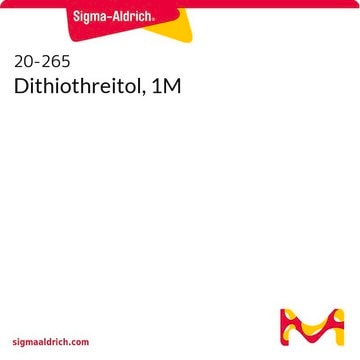If this product has an expiration or retest date, it will be shown on the Certificate of Analysis (COA, CofA). If there is no retest or expiration date listed on the product's COA, we do not have suitable stability data to determine a shelf life. For these products, the only date on the COA will be the release date; a retest, expiration, or use-by-date will not be displayed.
For all products, we recommend handling per defined conditions as printed in our product literature and website product descriptions. We recommend that products should be routinely inspected by customers to ensure they perform as expected.
For products without retest or expiration dates, our standard warranty of 1 year from the date of shipment is applicable.
For more information, please refer to the Product Dating Information document: https://www.sigmaaldrich.com/deepweb/assets/sigmaaldrich/marketing/global/documents/449/386/product-dating-information-mk.pdf
推薦產品
等級
for molecular biology
品質等級
產品線
BioUltra
化驗
≥99.5% (RT)
形狀
powder
反應適用性
reagent type: reductant
雜質
DNases, none detected
RNases, none detected
insoluble matter, passes filter test
phosphatases, none detected
proteases, none detected
≤0.3% 4,5-dihydroxy-1,2-dithiane
pH值
4.0-6.5 (25 °C, 0.1 M in H2O)
mp
41-44 °C (lit.)
溶解度
H2O: 0.1 M at 20 °C, clear, colorless
負離子痕跡
sulfate (SO42-): ≤50 mg/kg
正離子痕跡
Al: ≤5 mg/kg
As: ≤0.5 mg/kg
Ba: ≤5 mg/kg
Bi: ≤5 mg/kg
Ca: ≤10 mg/kg
Cd: ≤5 mg/kg
Co: ≤5 mg/kg
Cr: ≤5 mg/kg
Cu: ≤5 mg/kg
Fe: ≤5 mg/kg
K: ≤50 mg/kg
Li: ≤5 mg/kg
Mg: ≤5 mg/kg
Mn: ≤5 mg/kg
Mo: ≤5 mg/kg
Na: ≤500 mg/kg
Ni: ≤5 mg/kg
Pb: ≤5 mg/kg
Sr: ≤5 mg/kg
Zn: ≤5 mg/kg
&lambda ;
0.1 M in H2O
紫外吸收
λ: 260 nm Amax: 0.400
λ: 280 nm Amax: 0.100
SMILES 字串
O[C@H](CS)[C@H](O)CS
儲存溫度
2-8°C
InChI
1S/C4H10O2S2/c5-3(1-7)4(6)2-8/h3-8H,1-2H2/t3-,4-/m1/s1
InChI 密鑰
VHJLVAABSRFDPM-QWWZWVQMSA-N
尋找類似的產品? 前往 產品比較指南
一般說明
應用
生化/生理作用
特點和優勢
- BioUltra级粉末,适用于分子生物学研究
- 不含DNA酶、RNA酶和蛋白酶 不溶物通过过滤检测
- 经过严格检测,不含微量金属
同類產品
訊號詞
Danger
危險聲明
危險分類
Acute Tox. 4 Oral - Eye Dam. 1 - Skin Irrit. 2
儲存類別代碼
11 - Combustible Solids
水污染物質分類(WGK)
WGK 2
閃點(°F)
Not applicable
閃點(°C)
Not applicable
個人防護裝備
dust mask type N95 (US), Eyeshields, Faceshields, Gloves
客戶也查看了
文章
Understand how mRNA vaccines induce immunity. and read how synthetic mRNA is prepared for vaccine immunogens and other biopharmaceuticals. Find reagents for synthesis of mRNA.
瞭解 mRNA 疫苗如何誘發免疫力。閱讀合成 mRNA 如何製備疫苗免疫原和其他生物製藥。尋找合成 mRNA 的試劑。
-
How can I determine the shelf life / expiration / retest date of this product?
1 answer-
Helpful?
-
-
How is shipping temperature determined? And how is it related to the product storage temperature?
1 answer-
Products may be shipped at a different temperature than the recommended long-term storage temperature. If the product quality is sensitive to short-term exposure to conditions other than the recommended long-term storage, it will be shipped on wet or dry-ice. If the product quality is NOT affected by short-term exposure to conditions other than the recommended long-term storage, it will be shipped at ambient temperature. As shipping routes are configured for minimum transit times, shipping at ambient temperature helps control shipping costs for our customers. For more information, please refer to the Storage and Transport Conditions document: https://www.sigmaaldrich.com/deepweb/assets/sigmaaldrich/marketing/global/documents/316/622/storage-transport-conditions-mk.pdf
Helpful?
-
-
Is it normal for an IgG1 solution to become milky after DTT reduction?
1 answer-
It is uncommon for a reducing agent to cause protein precipitation. However, in some cases, the reduction of a protein with a reducing agent like DTT can result in a change in the isoelectric point of the protein or protein fragments. This change in pH may create conditions where precipitation of the protein is more likely to occur.
Helpful?
-
Active Filters
我們的科學家團隊在所有研究領域都有豐富的經驗,包括生命科學、材料科學、化學合成、色譜、分析等.
聯絡技術服務






